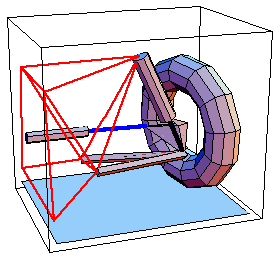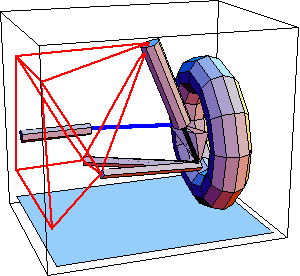4.1.3 3D Example MechanismA Modeler3D example model is developed to demonstrate the different angular velocity and acceleration formulations used by Modeler3D. This model is of a MacPherson strut automotive front suspension.
The model consists of only two moving bodies: the chassis and the wheel carrier. The wheel carrier is attached to the chassis by a lower A-arm, a MacPherson strut, and a steering tie rod that controls the steer angle of the wheel carrier. The A-arm, strut, and tie rod are not modeled as independent bodies in the model. They are each modeled as constraints that entirely represent the function they perform in the suspension. The input to the model is the chassis being moved vertically relative to the ground.
A MacPherson strut is attached to the chassis of a car by a ball joint, but it is attached to the wheel carrier in a cantilever fashion, not by another ball joint such as would be used in a more conventional double A-arm suspension. Thus, the MacPherson strut not only provides vertical support for the wheel carrier, it also provides the axis about which the wheel carrier pivots for steering. Since the strut cannot pivot with respect to the wheel carrier, it is modeled simply by forcing a ray on the wheel carrier to pass through a point on the chassis (the upper mounting point of the strut). This loads the Modeler3D package. Here is a 3D MacPherson strut front suspension model graphic.

BodiesThree body objects are defined for the MacPherson strut front suspension model. The ground body (body 1) requires four point definitions.
P1 is the origin of the ground body.
P2 is a point directly above P1 that is used in conjunction with P1 to define a vertical translation axis for the chassis.
P3 is a point on the X axis that is used with P1 to define a longitudinal axis that references the rotational orientation of the chassis.
P4 is a point on the Y axis that is used with P1 and P3 to define the horizontal plane of the ground upon which the tire rests.The chassis (body 2) requires seven local point definitions.
P1 is the origin of the chassis. This point lies at the center of the bottom of the chassis.
P2 is used in conjunction with P1 to define the vertical translation line of the chassis.
P3 is used with P1 to define a transverse axis on the chassis that is used to reference the rotational orientation of the chassis.
P4 and P5 are the two attachment points of the lower A-arm.
P6 is the upper mounting point of the MacPherson strut.
P7 is the attachment point of the steering tie rod. This point has a symbolic definition so that it can be moved in a transverse direction to steer the car.The wheel carrier (body 3) requires five local point definitions.
P1 is the local origin, which is the attachment point of the lower A-arm.
P2 is used with P1 to define the axis of the MacPherson strut on the carrier.
P3 is the center of the tire.
P4 is used with P3 to define the axis of the tire.
P5 is the attachment point of the steering tie rod on the wheel carrier.Names for each of the body numbers in the model are defined. Here are the three body objects used in the MacPherson strut model. The body objects are incorporated into the current model. ConstraintsEight constraints, including a driving constraint that is explicitly dependent on the time variable, are required to model the MacPherson strut front suspension. A Cylindrical4 constraint forces a vertical axis on the ground to be coincident with a vertical axis on the chassis, effectively allowing the chassis to slide up and down on a post.An Orthogonal1 constraint forces a longitudinal line on the ground to be orthogonal to a transverse line on the chassis. This constraint prevents the chassis from rotating about the vertical axis of rotation allowed by constraint 1.A RelativeZ1 constraint controls the vertical position of the chassis. This constraint is a function of the time variable T so it is the driving constraint.A RelativeDistance1 constraint models the front of the lower A-arm.A RelativeDistance1 constraint models the back of the lower A-arm.A PointOnLine2 constraint forces the axis of the MacPherson strut to pass through its upper mounting point on the chassis.A PlaneToCircle1 constraint forces the bottom of the tire to remain in contact with the ground. PlaneToCircle1 places the surface of a torus (or a circle) in contact with a plane.A RelativeDistance1 constraint models the steering tie rod.Here are the eight constraint objects for the MacPherson strut model. The constraints are incorporated into the current model. Note that the explicit symbol used to represent time in Modeler3D (T by default) may be changed. The SymbolBasis option for SetSymbols is a nested list of strings that determines the basis for all of the symbols created by Modeler3D in the Global` context. Changing the first element of SymbolBasis changes the symbol that is recognized as the time variable. SymbolBasis specifies the basis for Modeler3D automatic symbols.
Out[43]= |  |
RuntimeBecause of the presence of T in the driving constraint (constraint 3) the model can be run through its intended range of motion by varying T directly with the first argument to the SolveMech command. The way that this model is defined, the numerical value of T specifies the distance between the chassis and the ground. Now the model is run at T = 2.5.
Out[44]= |  |
Here is the MacPherson strut front suspension image at T = 2.5.

|